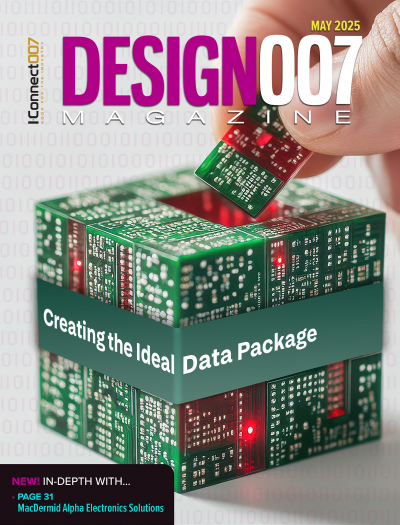-

-
News
News Highlights
- Books
Featured Books
- design007 Magazine
Latest Issues
Current Issue
All About That Route
Most designers favor manual routing, but today's interactive autorouters may be changing designers' minds by allowing users more direct control. In this issue, our expert contributors discuss a variety of manual and autorouting strategies.

Creating the Ideal Data Package
Why is it so difficult to create the ideal data package? Many of these simple errors can be alleviated by paying attention to detail—and knowing what issues to look out for. So, this month, our experts weigh in on the best practices for creating the ideal design data package for your design.

Designing Through the Noise
Our experts discuss the constantly evolving world of RF design, including the many tradeoffs, material considerations, and design tips and techniques that designers and design engineers need to know to succeed in this high-frequency realm.
- Articles
- Columns
- Links
- Media kit
||| MENU - design007 Magazine
Cadence Paper: Automating Inter-Layer In-Design Checks in Rigid-Flex PCBs
May 25, 2016 | Ed Hickey, Cadence Design SystemsEstimated reading time: 10 minutes
Inter-Layer Checks
Performing inter-layer checks allows the designer to check a variety of areas in the rigid-flex PCB design:
- Layer-to-layer checks to assess stack-up mask layers
- Coverlay to pad
- Mask to pad
- Precious metal to coverlay
- Bend area/line to stiffener, component, pin, and via
- Gaps, such as edge-to-edge spacing in areas such as the bend line to the component, the via to the bend line, and the stiffener to the bend area
- Inside areas, such as gold mask to coverlay, pin to coverlay, and stiffener adhesive to stiffener
- Overlaps when two geometries overlay by a minimum or more, such as soldermask overlay into the transition zone
Typically, designers have had to perform design rule checks (DRCs) manually, or write their own software to automate the process. There are also tools on the market that support rigid-flex design, but they are not particularly comprehensive in terms of the breadth of inter-layer checks now needed. A useful tool also needs to be able to address various design considerations, which we will outline in the next section.
Rigid-Flex Design Considerations
MCAD-ECAD Co-Design
All electronics have to fit into enclosures, making MCAD-ECAD co-design a necessity. However, rigid-flex PCBs call for additional scrutiny with the bending of the flex inside the enclosure. The mechanical engineer needs to provide the bend area, bend line, and bend radius to the PCB designer, who must create and adhere to various rules:
- Do not place vias in bend areas to avoid cracking the substrate over time
- Do not put pads too close to the bend area, as the pads can eventually peel off
- Avoid overlapping bend areas with stiffeners, or else there could be peeling or restriction of the full bend
- Avoid placing stiffeners too close to vias or pins to avoid shorting
Mechanical engineers must also define the specific boundaries for zones, where the thicknesses are different across the entire design structure. In return, mechanical engineers need to get additional data about layer structures and thickness for the zones, including above and below the top and bottom layers to calculate accurate thickness and accurate collision detection before handing the design to manufacturing. These layers include paste mask, coverlay, stiffeners, external copper, and other materials that impact overall height, thickness, and bend performance. See Figure 4 for a table showing ECAD-MCAD data transfer.
Component Placement
Due to various advances, CAD tools can now intelligently auto-drop components as they are moved across rigidflex substrate boundaries. This capability eliminates the tedious steps of moving the components to the right surface layers. But, are the results good enough? In most cases, component packages used for flex zones will differ from the ones used in rigid zones. For example, padstacks for flex zones tend to be longer to support the bending action of the material. Therefore, the CAD system should be able to “retarget” the package with the proper alternate symbol for the respective technology zone.
Interconnect
Routing flex vs. rigid generally comes down to one word: arcs. The nature of all geometry residing in a flex zone, whether it’s the board outline, teardrops, or routing, involves arcs and tapered transitions. CAD tools need to support group routing functions to carry a bus across the flex while locking to the contour of the board outline. Line-width transitions should be tapered and all pin/via junctions should be tear-dropped to reduce stress at the solder joints. Advances in CAD tools over the years have resulted in a better ability to push and shove traces during the edit commands. However, this has, for the most part, been a challenge with arc routes. Change, even daily change, is a given in PCB design. But adding an additional signal to a routed bus structure should not require designers to delete routes followed by the group reroute.
Page 2 of 4
Suggested Items
Driving Innovation: Direct Imaging vs. Conventional Exposure
07/01/2025 | Simon Khesin -- Column: Driving InnovationMy first camera used Kodak film. I even experimented with developing photos in the bathroom, though I usually dropped the film off at a Kodak center and received the prints two weeks later, only to discover that some images were out of focus or poorly framed. Today, every smartphone contains a high-quality camera capable of producing stunning images instantly.
Hands-On Demos Now Available for Apollo Seiko’s EF and AF Selective Soldering Lines
06/30/2025 | Apollo SeikoApollo Seiko, a leading innovator in soldering technology, is excited to spotlight its expanded lineup of EF and AF Series Selective Soldering Systems, now available for live demonstrations in its newly dedicated demo room.
Indium Corporation Expert to Present on Automotive and Industrial Solder Bonding Solutions at Global Electronics Association Workshop
06/26/2025 | IndiumIndium Corporation Principal Engineer, Advanced Materials, Andy Mackie, Ph.D., MSc, will deliver a technical presentation on innovative solder bonding solutions for automotive and industrial applications at the Global Electronics A
Fresh PCB Concepts: Assembly Challenges with Micro Components and Standard Solder Mask Practices
06/26/2025 | Team NCAB -- Column: Fresh PCB ConceptsMicro components have redefined what is possible in PCB design. With package sizes like 01005 and 0201 becoming more common in high-density layouts, designers are now expected to pack more performance into smaller spaces than ever before. While these advancements support miniaturization and functionality, they introduce new assembly challenges, particularly with traditional solder mask and legend application processes.
Knocking Down the Bone Pile: Tin Whisker Mitigation in Aerospace Applications, Part 3
06/25/2025 | Nash Bell -- Column: Knocking Down the Bone PileTin whiskers are slender, hair-like metallic growths that can develop on the surface of tin-plated electronic components. Typically measuring a few micrometers in diameter and growing several millimeters in length, they form through an electrochemical process influenced by environmental factors such as temperature variations, mechanical or compressive stress, and the aging of solder alloys.


